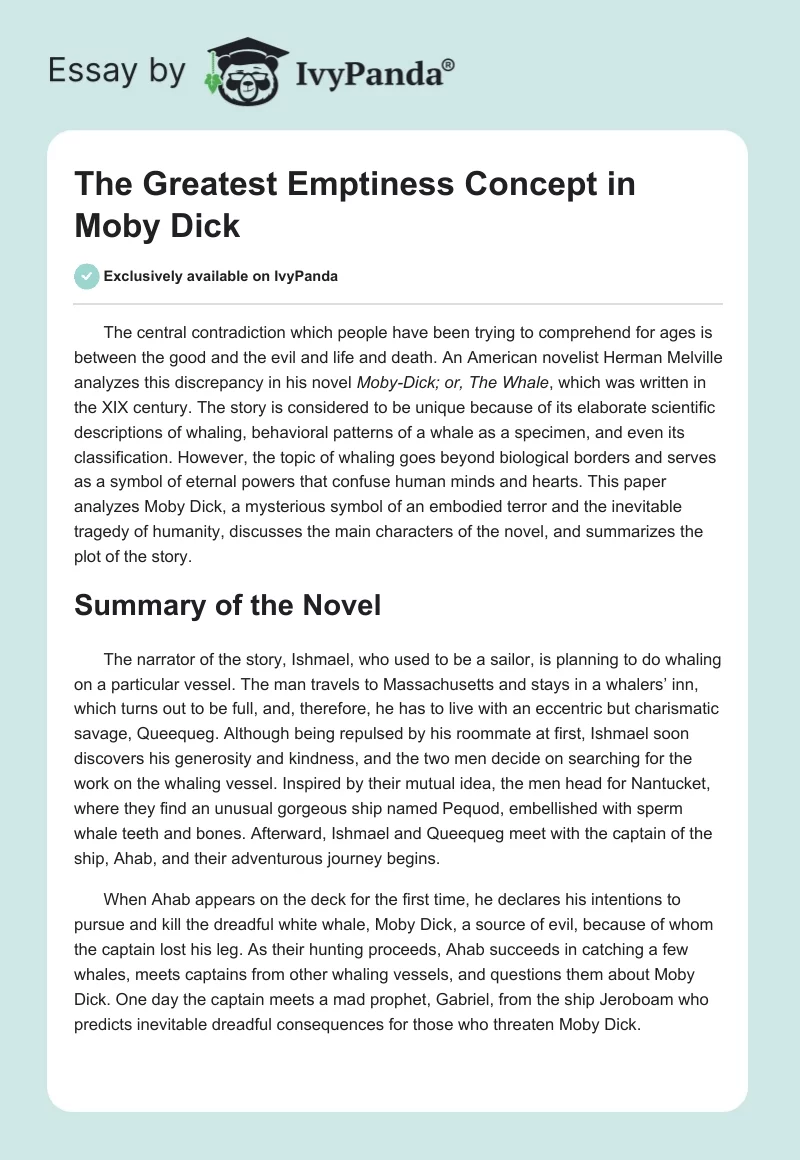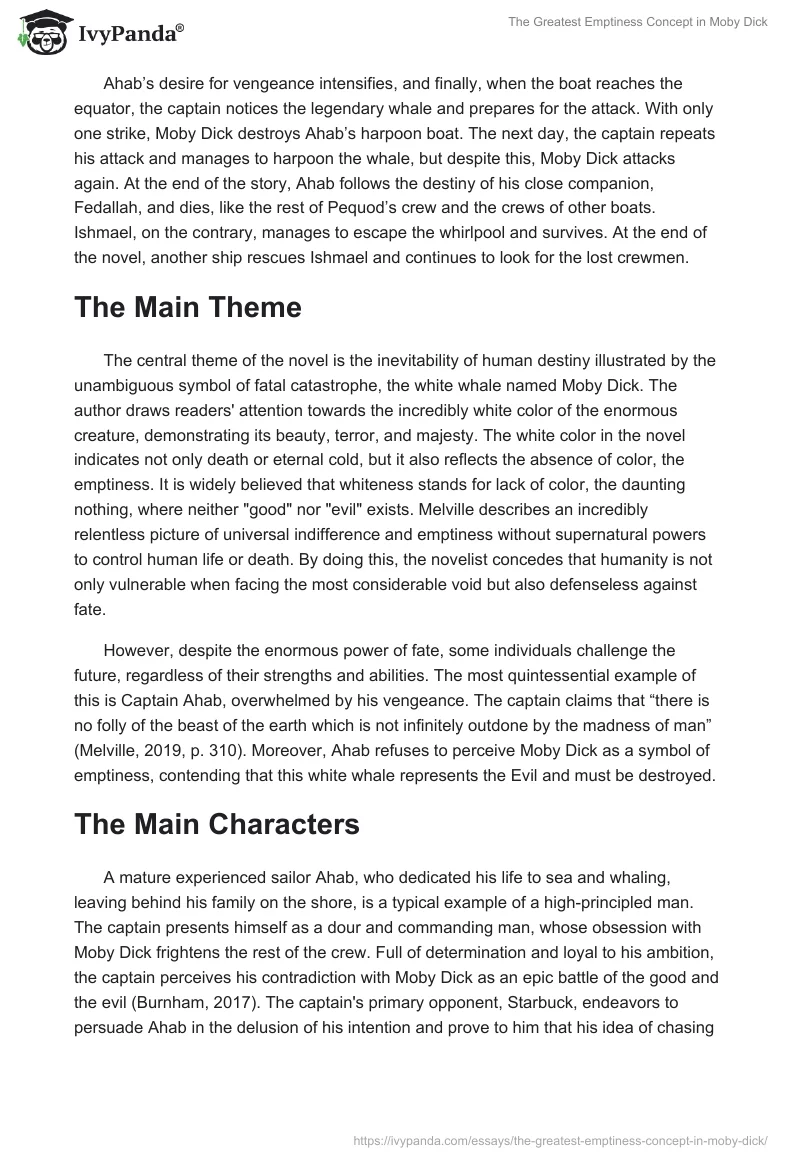The central contradiction which people have been trying to comprehend for ages is between the good and the evil and life and death. An American novelist Herman Melville analyzes this discrepancy in his novel Moby-Dick; or, The Whale, which was written in the XIX century. The story is considered to be unique because of its elaborate scientific descriptions of whaling, behavioral patterns of a whale as a specimen, and even its classification. However, the topic of whaling goes beyond biological borders and serves as a symbol of eternal powers that confuse human minds and hearts. This paper analyzes Moby Dick, a mysterious symbol of an embodied terror and the inevitable tragedy of humanity, discusses the main characters of the novel, and summarizes the plot of the story.
Summary of the Novel
The narrator of the story, Ishmael, who used to be a sailor, is planning to do whaling on a particular vessel. The man travels to Massachusetts and stays in a whalers’ inn, which turns out to be full, and, therefore, he has to live with an eccentric but charismatic savage, Queequeg. Although being repulsed by his roommate at first, Ishmael soon discovers his generosity and kindness, and the two men decide on searching for the work on the whaling vessel. Inspired by their mutual idea, the men head for Nantucket, where they find an unusual gorgeous ship named Pequod, embellished with sperm whale teeth and bones. Afterward, Ishmael and Queequeg meet with the captain of the ship, Ahab, and their adventurous journey begins.
When Ahab appears on the deck for the first time, he declares his intentions to pursue and kill the dreadful white whale, Moby Dick, a source of evil, because of whom the captain lost his leg. As their hunting proceeds, Ahab succeeds in catching a few whales, meets captains from other whaling vessels, and questions them about Moby Dick. One day the captain meets a mad prophet, Gabriel, from the ship Jeroboam who predicts inevitable dreadful consequences for those who threaten Moby Dick.
Ahab’s desire for vengeance intensifies, and finally, when the boat reaches the equator, the captain notices the legendary whale and prepares for the attack. With only one strike, Moby Dick destroys Ahab’s harpoon boat. The next day, the captain repeats his attack and manages to harpoon the whale, but despite this, Moby Dick attacks again. At the end of the story, Ahab follows the destiny of his close companion, Fedallah, and dies, like the rest of Pequod’s crew and the crews of other boats. Ishmael, on the contrary, manages to escape the whirlpool and survives. At the end of the novel, another ship rescues Ishmael and continues to look for the lost crewmen.
The Main Theme
The central theme of the novel is the inevitability of human destiny illustrated by the unambiguous symbol of fatal catastrophe, the white whale named Moby Dick. The author draws readers’ attention towards the incredibly white color of the enormous creature, demonstrating its beauty, terror, and majesty. The white color in the novel indicates not only death or eternal cold, but it also reflects the absence of color, the emptiness. It is widely believed that whiteness stands for lack of color, the daunting nothing, where neither “good” nor “evil” exists. Melville describes an incredibly relentless picture of universal indifference and emptiness without supernatural powers to control human life or death. By doing this, the novelist concedes that humanity is not only vulnerable when facing the most considerable void but also defenseless against fate.
However, despite the enormous power of fate, some individuals challenge the future, regardless of their strengths and abilities. The most quintessential example of this is Captain Ahab, overwhelmed by his vengeance. The captain claims that “there is no folly of the beast of the earth which is not infinitely outdone by the madness of man” (Melville, 2019, p. 310). Moreover, Ahab refuses to perceive Moby Dick as a symbol of emptiness, contending that this white whale represents the Evil and must be destroyed.
The Main Characters
A mature experienced sailor Ahab, who dedicated his life to sea and whaling, leaving behind his family on the shore, is a typical example of a high-principled man. The captain presents himself as a dour and commanding man, whose obsession with Moby Dick frightens the rest of the crew. Full of determination and loyal to his ambition, the captain perceives his contradiction with Moby Dick as an epic battle of the good and the evil (Burnham, 2017). The captain’s primary opponent, Starbuck, endeavors to persuade Ahab in the delusion of his intention and prove to him that his idea of chasing Moby Dick is a result of his impulsivity. Even able to defeat the obsessed captain at the right moment, Starbuck preserves his loyalty towards Ahab.
Ishmael, the narrator of the story, is a sailor whose affection and desire for the ocean led him to set out on the journey on Pequod. During the journey, the man continually observes diverse conflicts around him, related to ethnicity, race, or culture. Even though Ishmael seems to be a simple observer, his role is much more significant: the man “is the key figure regulating the global diversity on board of Pequod, working in effect as an agent of Ahab’s tyrannical rule” (Rowe, 2016, p. 321). Combining savagery and civilization in his character, harpooner Queequeg is presented as a noble and courteous man, despite his wild manners. The author depicts an incredibly intimate relationship between the harpooner and Ishmael to convey an idea of universal brotherhood, regardless of different ethnicities (Phillips, 2018).
Personal Opinion
Hence, the novel succeeds in covering most of the actual essential topics for the nineteenth century; all the problems remain similar, despite historical changes. In my opinion, Melville encourages readers to search for solutions to primary social issues such as tolerance and racism. Having demonstrated the consequences of a few situations described in the novel, the author has persuaded humanity in its imperfection and instability due to personal sins. I believe that the author’s idea of fighting one’s own demons like obsession or ignorance of the loyal ones can help an individual to survive the brutality of destiny.
Conclusion
The concept of the novel is illustrated by a universal symbol, Moby Dick, and its meaning, which remains strictly personal for every individual, depending on their perceptions and sentiments. Sophisticated relationships between the main characters, the concepts of eternal, uncontrollable powers, and the indication of human helplessness before merciless destiny convert the novel into an endless analysis of the fundamental organization of life. Although the book is an attempt to discover an answer to the questions of life’s meaning raised by the author, the discussion of them remains open even for modern communities.
References
Burnham, R. A. (2017). Reflections on the psychological aspects of Moby-Dick. Psychological Perspectives, 60(4), 465-473.
Melville, H. (2019). Moby-Dick; or, the whale. New York, NY: Harper Press.
Phillips, C. N. (2018). Sacred uncertainty: Religious difference and the shape of Melville’s career by Brian Yothers. Leviathan, 20(2), 112-115.
Rowe J.C., (2016). Moby-Dick and Globalization. In M. Graham & W. Raussert (Eds.) Mobile and Entangled America (s) (pp. 321-336). Abington, UK: Routledge.


